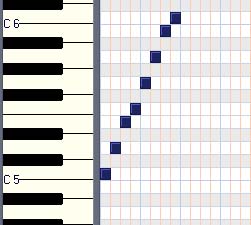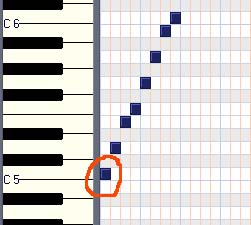Hopefully you have a working knowledge of theory, if not I will try and keep this as simple as possible.
This article is an expansion of the previous article, The Major Scale and Intervals.
I’m going to use Sonars piano roll and staff views, the piano roll will fit the same with Reaper, Cubase and any other DAW that uses it.
Before we begin need to see the relationship between intervals and scales.
For this article to keep things simple we’re going to work in the key of ‘C’.
C Major scale works like this,
C D E F G A B C
So from the screen prints above of the staff view and the piano roll you see how a scale works.
Starting from the lowest point you work up through the scale,
C D E F G A B C
C D E F G A B C
Before we looked at these screen prints, I have written out the scale as below,
C D E F G A B C
I II III III V VI VII VIII
The roman numerals below each note gives us the degree in the scale.
These numbers are important in our understanding of the intervals.
In the major scale each interval is given a name,
I = Root Note/Tonic
II = Major 2nd
III = Major 3rd
IV = Perfect 4th
V = Perfect 5th
VI = Major 6th
VII = Major 7th
VIII= Octave
These names derive not from the notes position in the scale but in it’s relationship to the root/tonic or the 1st note.
This is called the interval.
So the interval from I to II is called a Major 2nd – in C major this is C to D
So the interval from I to III is called a Major 3rd – in C major this is C to E
So the interval from I to IV is called a Perfect 4th – in C major this is C to F
So the interval from I to V is called a Perfect 5th – in C major this is C to G
So the interval from I to VI is called a Major 6th – in C major this is C to A
So the interval from I to VII is called a Major 7th – in C major this is C to B
So the interval from I to VIII is called a Octave – in C major this is C to C
Getting to grips with each interval, it’s relationship to the root/toonic and primarily it’s sound is important.
Playing each interval and listening to it’s sound is a neccesity when learning to compose both melody and chord structure not to mention harmony.
Whatever instrument you play it is important that you learn the notes and where they are.
As primarily a guitarist and sub par keyboard player I have a very good knowledge of the notes and there they are on each instrument.
In the next article I’ll be going over how to play the intervals for those who need to know.
:::End of part 1:::
Theory: Working with Intervals (part 2)
Related Articles:



